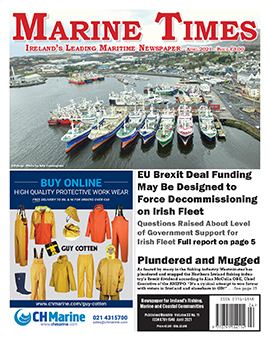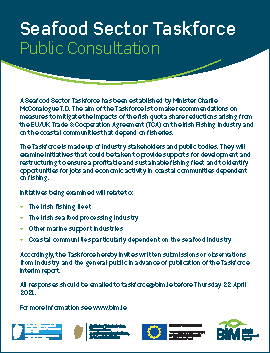Importance of foodservice, a diversified portfolio and sector resilience key to seafood industry performance in 2020
The volume of landings into Irish ports fell by 4% in 2020, to 252,000 tonnes, this decline being driven by the Irish fleet, landing 10% less than 2019 while landing volumes of non-Irish vessels increased by 17%. The value of landings fell 18% in 2020 to €346m with the Irish fleet contributing the most to this decline falling by 26% in value.
Despite the challenges of the global Covid-19 pandemic in 2020, the seafood sector remained resilient and adapted to the significant market disruption it faced, according to an economic assessment of the sector carried out by Bord Iascaigh Mhara (BIM).
The total value of Ireland’s seafood economy in 2020 was just under €1.1 billion. As with many other industries and sectors the pandemic has had an impact, and when compared year on year it represents a decrease of 12% (-€142million). This was driven mainly by the severe disruption in global markets. In addition, the continued uncertainty of the UK’s departure from the EU made for challenging trading conditions. These factors, as well as the effective closure of the foodservice sector for much of 2020, saw a reduction of 18% in domestic consumption. While exports to key markets in Europe and Asia fell, opportunities in other global markets emerged as the value of exports to Africa growing by 87% and by 43% to the Middle East driven by increased exports of mackerel.
Despite the pandemic, and even with reduced demand in the foodservice sector, employment in the seafood sector remained stable in 2020, and there continued to be more than 16,000 people employed directly and indirectly in the seafood industry. Employment remains high in coastal regions, generating significant socioeconomic value in these areas (16% in Donegal, 7% in Cork, 6% in Galway-Clare and 6% along the coastal region of the east coast).
Launching the report, Minister Charlie McConalogue said; “Undoubtedly 2020 was a challenging year for the seafood sector but yet again the sector displayed its ability to adjust and refocus to the available market opportunities. The Seafood sector maintained a strong and important continuous supply of top quality seafood overcoming the challenges presented by the pandemic.”
Speaking about the resilience the industry has demonstrated in the face of adversity BIM, CEO Jim O’Toole said, “There is no doubt that 2020 was a difficult year for the seafood industry with many markets experiencing reduced demand, directly related to the Covid-19 pandemic. The Irish seafood sector sells a lot of its produce to foodservice markets in Europe and in Asia which experienced lengthy lockdowns significantly impacting sales. The industry showed great agility during the year and looked to alternatives for its products, switching where possible from supplying hospitality to supplying the retail market and online sales. Looking ahead, there are many reasons to be hopeful and the sector is set to avail of the opportunities that will emerge as markets reopen and we can look forward to some recovery as 2021 progresses, notwithstanding the new challenges introduced by the Trade and Cooperation Agreement with the UK.”
Value of seafood industry:
The estimated value of the seafood industry in 2020 was €1.1 billion, down 18%, mainly due to a fall in sales in foodservice, however this was somewhat offset by a 6% increase (€18m) in retail sales.
Domestic consumption amounted to €406m, down 18%, exports-imports were valued at €263m, down 10% and private investment was valued at €213, down 17% reflecting the uncertainty in the markets leading to cautious activity from many seafood businesses. However, there was an increase of 9% on government investment – an increase to €203m.
It’s worth noting that overall investment in the sector was €416 million, equivalent to 39% of seafood GDP, a slight increase compared to 2019, underlining the importance of strong public-sector support through times of economic turbulence.

.jpg)


.jpg)
 Facebook
Facebook Twitter
Twitter